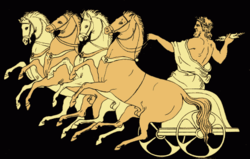|
Greek city of Antioch in SELEUKIS AND PIERIA
Bronze 18mm (5.05 grams) Struck circa 47-18 B.C.
Reference: RPC I 4299; SNG Copenhagen 83 var. (caduceus left of tripod)
Laureate head of Zeus right.
ANTIOXEΩN / MHTPOΠOΛΕΩΣ and AYTONOMOY on either side of tripod of Apollo.
You are bidding on the exact item pictured,
provided with a Certificate of Authenticity and Lifetime Guarantee of
Authenticity.
In the
ancient Greek
religion
, Zeus
zews
zooss
;
Ancient Greek
: Ζε�ς;
Modern
Greek
: Δίας, Dias) was the “Father of Gods and men” (πατὴÏ�
ἀνδ�ῶν τε θεῶν τε)
who ruled the Olympians of
Mount
Olympus
as a father ruled the family. He was the
god of sky
and
thunder
in
Greek mythology
. His
Roman
counterpart is
Jupiter
and
Etruscan
counterpart is
Tinia
.![The Jupiter de Smyrne, discovered in Smyrna in 1680[1]](https://upload.wikimedia.org/wikipedia/commons/thumb/c/c8/Jupiter_Smyrna_Louvre_Ma13.jpg/200px-Jupiter_Smyrna_Louvre_Ma13.jpg)
Zeus was the child of
Cronus
and
Rhea
, and the youngest of his siblings. In most
traditions he was married to
Hera, although, at the oracle of
Dodona
, his consort was
Dione
: according to the
Iliad
, he is the father of
Aphrodite
by Dione.
He is known for his erotic escapades. These resulted in many godly and heroic
offspring, including
Athena
,
Apollo
and
Artemis
,
Hermes
,
Persephone
(by
Demeter
),
Dionysus
,
Perseus
,
Heracles
,
Helen of Troy
,
Minos
, and the
Muses (by
Mnemosyne
); by Hera, he is usually said to have
fathered Ares
,
Hebe
and
Hephaestus
.
As
Walter Burkert
points out in his book, Greek
Religion, “Even the gods who are not his natural children address him as
Father, and all the gods rise in his presence.”
For the Greeks, he was the
King of the Gods
, who oversaw the universe. As
Pausanias
observed, “That Zeus is king in
heaven is a saying common to all men”.
In Hesiod’s Theogony
Zeus assigns the various gods
their roles. In the
Homeric Hymns
he is referred to as the
chieftain of the gods.
His symbols are the
thunderbolt
,
eagle
,
bull
, and
oak.
In addition to his Indo-European inheritance, the classical “cloud-gatherer”
also derives certain iconographic traits from the cultures of the
Ancient Near East
, such as the
scepter
. Zeus is frequently depicted by Greek
artists in one of two poses: standing, striding forward, with a thunderbolt
leveled in his raised right hand, or seated in majesty.
Etymology

The Chariot of Zeus, from an 1879 Stories from the Greek
Tragedians by Alfred Church
A sacrificial tripod was a type of
altar
used by the
ancient Greeks. The most famous was the
Delphic
tripod
, on
which the Pythian
priestess
took her seat to deliver the
oracles
of the
deity. The seat was formed by a circular slab on the top of the tripod, on which
a branch of
laurel
was deposited when it was unoccupied by the priestess. In this sense,
by Classical times the tripod was sacred to
Apollo
. The
mytheme
of
Heracles
contesting with Apollo for the tripod appears in vase-paintings older than the
oldest written literature. The oracle originally may have been related to the
primal deity, the Earth.
Another well-known tripod was the
Plataean Tripod
, made from a tenth part of the spoils taken from the
Persian
army after the
Battle of Plataea
. This consisted of a golden basin, supported by a
bronze
serpent
with three heads (or three serpents intertwined), with a list of the
states that had taken part in the war inscribed on the coils of the serpent. The
golden bowl was carried off by the
Phocians
during
the
Third Sacred War
; the stand was removed by the emperor
Constantine
to
Constantinople
(modern
Istanbul
),
where it still can be seen in the
hippodrome
, the Atmeydanı, although in damaged condition, the heads
of the serpents disappeared however one is now on display at the nearby Istanbul
Archaeology Museums. The inscription, however, has been restored almost
entirely. Such tripods usually had three ears (rings which served as
handles) and frequently had a central upright as support in addition to the
three legs.
Tripods frequently are mentioned by
Homer
as prizes
in
athletic games
and as complimentary gifts; in later times, highly decorated
and bearing inscriptions, they served the same purpose. They also were used as
dedicatory offerings
to the deities, and in the dramatic contests at the
Dionysia
the victorious
choregus
(a wealthy citizen who bore the expense of equipping and training
the chorus) received a crown and a tripod. He would either dedicate the tripod
to some deity or set it upon the top of a marble structure erected in the form
of a small circular temple in a street in
Athens
, called
the street of tripods, from the large number of memorials of this kind.
One of these, the
Choragic Monument of Lysicrates
, erected by him to commemorate his victory
in a dramatic contest in
335 BC
, still
stands. The form of the victory tripod, now missing from the top of the
Lysicrates monument, has been rendered variously by scholars since the
eighteenth century.
The scholar
Martin L. West
writes that the sibyl at Delphi shows many traits of
shamanistic
practices, likely inherited or influenced from Central Asian
practices. He cites her sitting in a cauldron on a tripod, while making her
prophecies, her being in an ecstatic trance state, similar to shamans, and her
utterings, unintelligible.
According to Herodotus (The Histories, I.144), the victory tripods were not
to be taken from the temple sanctuary precinct, but left there for dedication.
|




![The Jupiter de Smyrne, discovered in Smyrna in 1680[1]](https://upload.wikimedia.org/wikipedia/commons/thumb/c/c8/Jupiter_Smyrna_Louvre_Ma13.jpg/200px-Jupiter_Smyrna_Louvre_Ma13.jpg)




